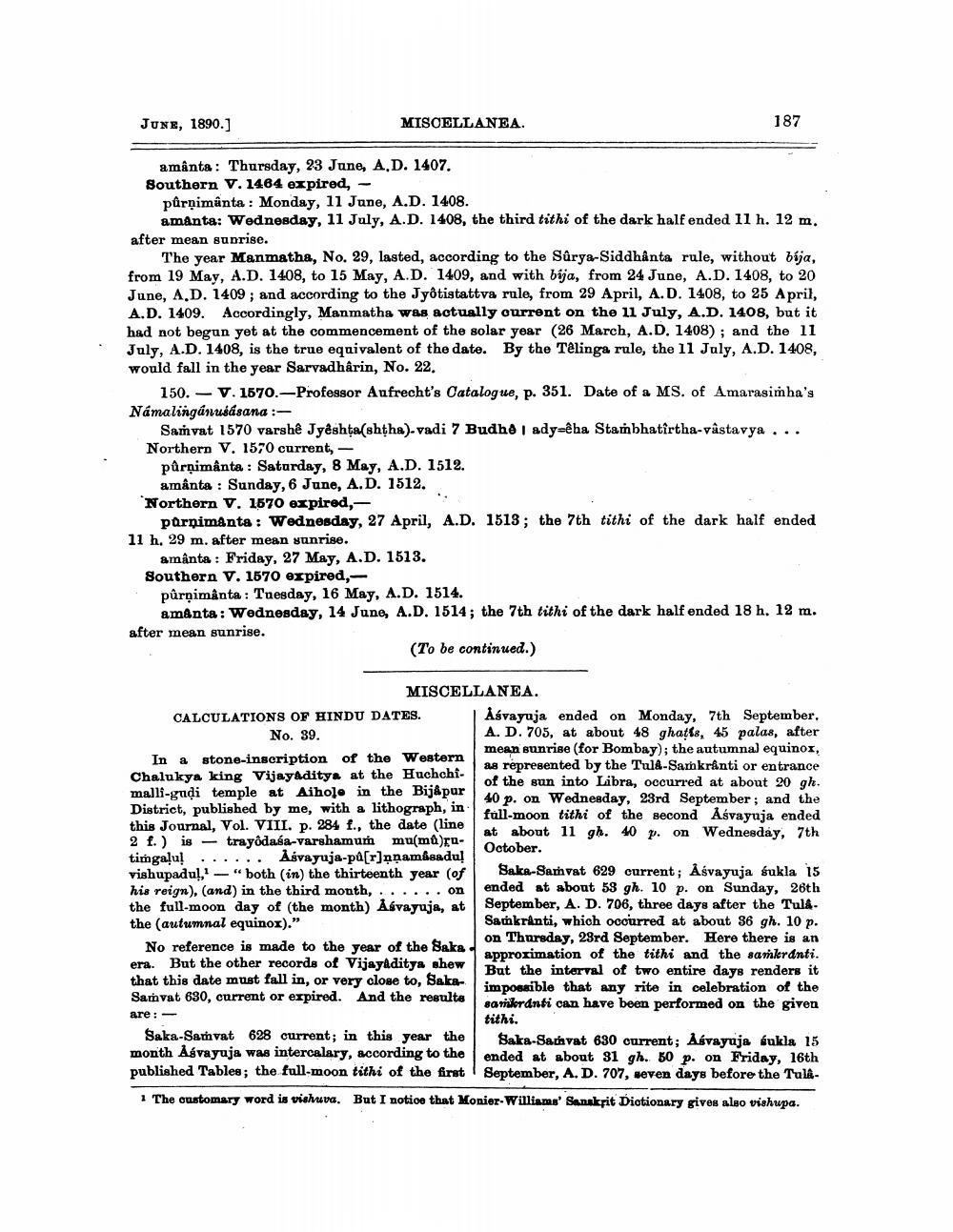________________
JUNE, 1890.]
MISCELLANEA.
amânta: Thursday, 23 June, A.D. 1407. Southern V. 1464 expired,
-
pûrnimânta: Monday, 11 June, A.D. 1408.
amanta: Wednesday, 11 July, A.D. 1408, the third tithi of the dark half ended 11 h. 12 m. after mean sunrise.
The year Manmatha, No. 29, lasted, according to the Sûrya-Siddhânta rule, without bija, from 19 May, A.D. 1408, to 15 May, A.D. 1409, and with bija, from 24 June, A.D. 1408, to 20 June, A.D. 1409; and according to the Jyôtistattva rule, from 29 April, A.D. 1408, to 25 April, A.D. 1409. Accordingly, Manmatha was actually current on the 11 July, A.D. 1408, but it had not begun yet at the commencement of the solar year (26 March, A.D. 1408); and the 11 July, A.D. 1408, is the true equivalent of the date. By the Têlinga rule, the 11 July, A.D. 1408, would fall in the year Sarvadhârin, No. 22.
150. V. 1570.-Professor Aufrecht's Catalogue, p. 351. Date of a MS. of Amarasimha's Námalingánusásana :
Samvat 1570 varshê Jyêshta(shtha)-vadi 7 Budhe | ady-êha Stambhatîrtha-vâstavya . . . Northern V. 1570 current, -
pûrṇimânta: Saturday, 8 May, A.D. 1512.
amânta Sunday, 6 June, A.D. 1512.
Northern V. 1570 expired,
purnimanta: Wednesday, 27 April, A.D. 1513; the 7th tithi of the dark half ended 11 h. 29 m. after mean sunrise.
amânta: Friday, 27 May, A.D. 1513.
Southern V. 1570 expired,
pûrnimânta: Tuesday, 16 May, A.D. 1514.
amanta: Wednesday, 14 June, A.D. 1514; the 7th tithi of the dark half ended 18 h. 12 m. after mean sunrise.
(To be continued.)
MISCELLANEA.
CALCULATIONS OF HINDU DATES. No. 39.
In a stone-inscription of the Western Chalukya king Vijayaditya at the Huchchimalli-gudi temple at Aihole in the Bijapur District, published by me, with a lithograph, in this Journal, Vol. VIII. p. 284 f., the date (line 2 f.) is trayôdasa-varshamum mu(mû)ṛutimgaļu!
187
Asvayuja-pu[r]nṇamâsadu! vishupadul,'-"both (in) the thirteenth year (of his reign), (and) in the third month, .. .. on the full-moon day of (the month) Asvayuja, at the (autumnal equinox)."
No reference is made to the year of the Saka era. But the other records of Vijayaditya shew that this date must fall in, or very close to, SakaSamvat 630, current or expired. And the results
are:
Saka-Samvat 628 current; in this year the month Asvayuja was intercalary, according to the published Tables; the full-moon tithi of the first 1 The customary word is vishuva. But I notice that
Asvayuja ended on Monday, 7th September. A. D. 705, at about 48 ghatis, 45 palas, after mean sunrise (for Bombay); the autumnal equinox, as represented by the Tula-Samkrânti or entrance of the sun into Libra, occurred at about 20 gh. 40 p. on Wednesday, 23rd September; and the fall-moon tithi of the second Asvayuja ended at about 11 gh. 40 p. on Wednesday, 7th October.
Saka-Samvat 629 current; Asvayuja sukla 15 ended at about 53 gh. 10 p. on Sunday, 26th September, A. D. 706, three days after the Tul&Samkranti, which occurred at about 36 gh. 10 p. on Thursday, 23rd September. Here there is an
approximation of the tithi and the samkranti. But the interval of two entire days renders it impossible that any rite in celebration of the samkranti can have been performed on the given tithi.
Saka-Samvat 630 current; Asvayuja ukla 15 ended at about 31 gh. 50 p. on Friday, 16th September, A. D. 707, seven days before the TulêMonier-Williams' Sanskrit Dictionary gives also vishupa.




